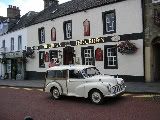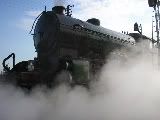<blockquote id="quote"><font size="1" face="Century Gothic, Verdana, Arial, Helvetica" id="quote">quote:<hr height="1" noshade id="quote"><i>Originally posted by Hasbeen</i>
Looking at the geometry, I can see absolutely no reason why one of
these kits should reduce the diving under brakes.
<hr height="1" noshade id="quote"></font id="quote"></blockquote id="quote">
you all know what front suspension looks like , standard mcpherson suspension , we have a strut and a lower arm. the lower arm is composed of 2 parts , anti-roll bar and a control arm. on a stock tr the plane that the lower arm(antiroll bar & controll arm) defines is parallel to the ground. braking force transmited to the body goes along that plane , and since it is parallel to the ground the distance from the center of gravity to the plane in which the braking force acts is large.
in the picture :
Red dot - center of mass
Green rectangles - standard suspension points
orange line - plane that standard suspension forms
Red letter A - length at which the braking force acts to make the car dive. ( the longer that distance, car dives more , shorter the distance car, dives less, no distance , car doesnt dive at all)

why do all cars dive under braking ,or squat under acceleration, because the forces( and their reactions) act below the center of mass.
so that anti dive kit does the following , moving the suspension points we tilt the plane in which the braking forces act. shortening the distance between center of mass and that plane.
on the picture
Blue rectangles - modified suspension geometry
Red line - the plane in which the braking forces act
Red letter- length at which the braking force acts to make the car dive.
so by moving the suspension point we shorten the leverage of the forces that roll the car over the front suspension. on the same force less leverage means less moment .
ive exaggerated the drawing so the real anti dive gains are much lower ( maybe 5-10%)






 <font color="red"><b>My two 1980 Wedges...</b></font id="red">
<font color="red"><b>My two 1980 Wedges...</b></font id="red">



